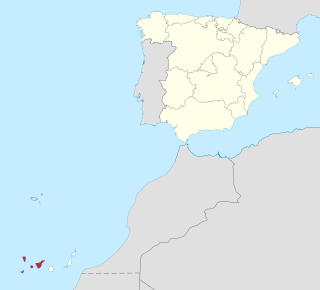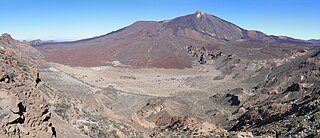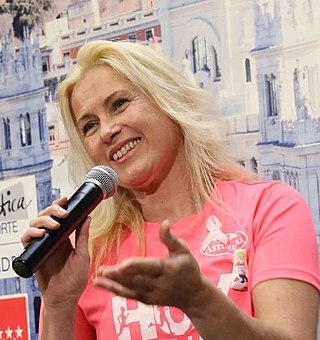Related Research Articles

The Canary Islands, also known informally as the Canaries, are a Spanish autonomous community and archipelago in Macaronesia in the Atlantic Ocean. At their closest point to the African mainland, they are 100 kilometres west of Morocco. They are the southernmost of the autonomous communities of Spain. The islands have a population of 2.2 million people and are the most populous special territory of the European Union.

Province of Santa Cruz de Tenerife, also Province of Santa Cruz, is a province of Spain, consisting of the western part of the autonomous community of the Canary Islands. It consists of about half of the Atlantic archipelago: the islands of Tenerife, La Gomera, El Hierro, and La Palma. It occupies an area of 3,381 km2 (1,305 sq mi). It also includes a series of adjacent roques.

The Rarámuri or Tarahumara is a group of indigenous people of the Americas living in the state of Chihuahua in Mexico. They are renowned for their long-distance running ability.

Tenerife is the largest and most populous island of the Canary Islands. It is home to 43% of the total population of the archipelago. With a land area of 2,034 square kilometres (785 sq mi) and a population of 978,100 inhabitants as of January 2022, it is also the most populous island of Spain and of Macaronesia.

An ultramarathon, also called ultra distance or ultra running, is any footrace longer than the traditional marathon length of 42.195 kilometres. Various distances are raced competitively, from the shortest common ultramarathon of 50 kilometres (31 mi) to over 200 miles (320 km). 50k and 100k are both World Athletics record distances, but some 100 miles (160 km) races are among the oldest and most prestigious events, especially in North America.

Teide, or Mount Teide, is a volcano on Tenerife in the Canary Islands, Spain. Its summit is the highest point in Spain and the highest point above sea level in the islands of the Atlantic.

Teide National Park is a national park located in Tenerife, Canary Islands, Spain.
Tourism is an essential part of the economy of the Canary Islands, a Spanish archipelago located in the Atlantic Ocean, 100 kilometres west of Morocco. Seven main islands and six islets make up the Canary Islands. They had more than 9 million foreign incoming tourists in 2007. Tourists seeking sunshine and beaches first began to visit the Canaries in large numbers in the 1960s. The Canary Islands are a leading European tourist destination with very attractive natural and cultural resources.

On the island of Tenerife, in the Canary Islands, many sports are practiced, both outdoors and indoors in the various facilities available throughout the island.

Alberto Suárez Laso is a T12 athlete from Spain who competes in long-distance events like the 5,000 meters, 10,000 meters, half marathon and marathon. He is a world record holder in the men's T12 marathon, winning gold in the event at the 2011 IPC Athletics World Championships and the 2012 Summer Paralympics.
Rafael Botello Jiménez is a Spanish wheelchair athlete specializing in long-distance events. He has represented Spain at the 2008 and the 2012 Summer Paralympics.
Elisabet Barnes is a Swedish athlete specialized in ultrarunning. Her major claim to fame is winning the Marathon des Sables in 2015, winning each stage of the race. She repeated her win in 2017. The Marathon des Sables has been listed by Outside Magazine as one of the 9 toughest ultramarathons in the world. In 2015, she participated in six races, winning all and setting new course records in four.
José García Gaspar is a Mexican long-distance runner. He competed in the marathon at the 1968 Summer Olympics. Nació en Villa Victoria, el 19 de marzo de 1946. Atleta que ha destacado en carreras de 5,000 y 10,000 metros, en las que obtuvo el primer lugar; en 1965 viajó a la ciudad de Morelia y concursó en esa categoría, obteniendo el primer lugar; posteriormente fue a Jalapa, Veracruz, donde obtuvo el primer lugar; siguió su trayectoria de triunfos en varios estados del país. Miembro destacado del Centro Olímpico Mexicano, representó a México en las Olimpiadas de 1968, logrando un tercer lugar y medalla de bronce. En varios maratones como el de Cuba obtuvo el cuarto lugar, en 1969, en Panamá, el segundo lugar; en Boston, el séptimo lugar; en Chicago, el tercero; en Puerto Rico, el tercer lugar; en Toronto, Canadá, el segundo lugar ; nuevamente en Puerto Rico, en el maratón de San Blas, ganó el tercer lugar, en Colombia, y el segundo lugar en Tokio, Japón. Su última participación a nivel internacional la hizo en Guadalajara, Jalisco, al lado de varios extranjeros, consiguiendo un segundo lugar; desde este maratón calificó para los Juegos Olímpicos de Rusia. Se le apoda "el pequeño gigante del atletismo mexicano".

The Barcelona Trail Races or BTR is a running event that includes several mountain races or trail running races. It takes place once a year in the Collserola Park in Barcelona, Catalonia, Spain. The first edition was in 2013.

Salvavidas de Hielo is the eleventh studio album by Uruguayan singer and songwriter Jorge Drexler, released on September 22, 2017, through Warner Music. It was produced by Carles Campón, frequent collaborator of Drexler, and features collaborations with Chilean singer Mon Laferte and Mexican singers Julieta Venegas and Natalia Lafourcade, the latter in the title track.

Teide Cableway is an aerial tramway that goes up Mount Teide, the highest peak in Spain, located in Teide National Park in Tenerife, Canary Islands. Starting at the base station at 2,356 metres (7,730 ft) above sea level, it ascends to the top station at 3,555 m (11,663 ft) in eight minutes, at a maximum speed of 8 m/s (26 ft/s) and carrying 44 people per cabin. Conceived in 1929, construction of the cableway started on 5 September 1963 and was completed on 27 July 1971, starting operations on 2 August 1971. It was renovated between 1999 and 2007.
María Lorena Ramírez Hernández is an indigenous long-distance runner belonging to the Rarámuri ethnic group, who lives in the state of Chihuahua, Mexico. She became known internationally after having won the Cerro Rojo UltraTrail in 2017, an ultra-distance race of 50 kilometers, in a time of 07:20, and for having also done it with huaraches, without shoes or sports equipment. She competes wearing traditional garb, including her trademark long skirt. Despite being a high-performance athlete, she does not receive government sports support. Her example influences Rarámuri children to develop as runners in the heights of the sierra in Chihuahua.

Gema Victoria Hassen-Bey González is a Spanish journalist and wheelchair fencer. She has competed at several Paralympics and she won two medals in 1992. She was the flag bearer for Spain in 2004. She has taken part in wheelchair mountain climbing.
References
- ↑ Unos 2.700 atletas de 33 países participarán en la carrera de montaña 'CajaMar Tenerife Bluetrail 2017'
- ↑ Tenerife Bluetrail, la carrera más alta de España
- ↑ Unos 2.700 atletas de 33 países participarán en la carrera de montaña 'CajaMar Tenerife Bluetrail 2017'
- ↑ La Cajamar Tenerife Bluetrail 2017 bate el récord de inscritos con 2.700 corredores
- ↑ La rarámuri Lorena Ramírez queda tercera en un ultramaratón tras correr 102 kilómetros por el Teide